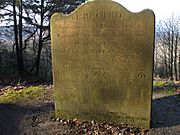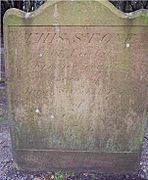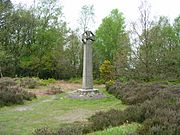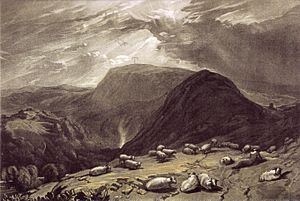Unknown Sailor facts for kids
The Unknown Sailor was a seafarer who was sadly killed in September 1786 near Hindhead in Surrey, England. His killers were later punished for their crime near the same spot the next year.
Contents
The Sailor's Story
The Unknown Sailor was first seen at the Red Lion Inn in Thursley. He was walking from London to join his ship in Portsmouth on September 24, 1786. At the inn, he met three other sailors: James Marshall, Michael Casey, and Edward Lonegon. The Unknown Sailor was kind and paid for their food and drinks. He was last seen leaving with them for Hindhead Hill.
The three other sailors attacked him and took his clothes. They then walked along the London to Portsmouth road (now the A3). A few hours later, they were caught trying to sell the sailor's clothes at the Sun Inn in Rake.
Six months later, the three men were tried in court at Kingston. Two days after their trial, on April 7, 1787, they were executed near where the crime happened in Hindhead.
Remembering the Sailor
The Sailor's Gravestone
The Unknown Sailor was buried in Thursley churchyard. The people of the village paid for his gravestone. It says:
In memory of
A generous but unfortunate Sailor
Who was barbarously murder'd on Hindhead
On September 24th 1786
By three Villains
After he had liberally treated them
And promised them his farther assistance
On the road to Portsmouth.
This gravestone is a very important historical structure, called a Grade-1 listed building. It was cleaned and made to look new again in 2010.
The Sailor's Stone
The Sailor's Stone was put up by James Stillwell from nearby Cosford Mill. This happened soon after the sailor was killed. The stone was placed on the old road from London to Portsmouth, close to where the crime took place.
The words on the front of the stone say:
ERECTED
In detestation of a barbarous Murder
Committed here on an unknown Sailor
On Sep, 24th 1786
By Edwd. Lonegon, Mich. Casey & Jas. Marshall
Who were all taken the same day
And hung in Chains near this place
Whoso sheddeth Man's Blood by Man shall his
Blood be shed. Gen Chap 9 Ver 6
See the back of this stone
THIS STONE WAS ERECTED
A.D. 1786 BY JAMES STILLWELL ESQRE. OF COSFORD
AND WAS RENOVATED SEP 24TH 1889 BY
JAMES JOHN RUSSELL STILLWELL ESQRE OF KILLINGHURST
THE DESCENDANT AND REPRESENTATIVE OF THE STILLWELLS
OF COSFORD AND MOUSHILL
The words on the back of the stone say:
THIS STONE
was Erected
by order and at
the cost of
James Stilwell Esqr.
of
Cosford
1786
Cursed be the Man who injureth
or removeth this Stone
The Sailor's Stone has been moved several times over the years. It was first moved in 1826 when the road was changed. Then it was moved back to its original spot. Later, it was moved again to the Punch Bowl road. Finally, in 1932, it was moved back to its original location when the main road was made wider.
You can find the Sailor's Stone at these coordinates: 51°06′52.5″N 0°43′6.9″W / 51.114583°N 0.718583°W.
The Celtic Cross
In 1851, Sir William Erle paid for a large granite Celtic Cross to be built. It stands on Gibbet Hill, where the criminals were punished. He wanted to help local people feel less afraid and more hopeful.
The cross has four Latin sayings carved around its base. They mean: "Light after darkness. Peace in passing away. Hope in light. Salvation after death."
The Celtic Cross is located at 51° 06’ 56.1”N, 0° 42’ 58.2”W.
The Sailor in Art and Books
Turner's Painting
Between 1807 and 1809, the famous painter Turner created a series of artworks called Liber Studiorum. One of these, number 25, shows Hindhead Hill with the gibbet clearly visible.
Turner was inspired by the sad story of the place. He even wrote some short poems about it. In his drawing for the artwork, he carefully showed the shapes of the three bodies on the gallows. He also changed the outline of the gibbet to look like the letter 'T'. Some people think this was a clever hint to his own name, Turner.
His poems included lines like "Hind head thou cloud capt hill" and "Hark the kreaking Irons. Hark the screaching owl."
In Nicholas Nickleby
Charles Dickens wrote about the Unknown Sailor's murder in his book Nicholas Nickleby, published in 1838-9.
In the story, the characters Nicholas Nickleby and Smike visit the Devil's Punch Bowl. Smike listens carefully as Nicholas reads the words on the stone. The stone tells the story of the murder that happened there at night. Nicholas thinks that the Devil's Punch Bowl "never held fitter liquor" than the blood spilled there.
In The Broom-squire
In the early 1800s, families called Broom-squires lived in the Devil's Punch Bowl. They made and sold brooms. They were very independent people.
In 1896, the Reverend Sabine Baring-Gould wrote a book called The Broom-Squire. It tells a made-up story about a girl named Mehetabel. She is supposedly the daughter of the Unknown Sailor. The book describes her difficult life with one of the Broom-squires, Bideabout.
In Punchbowl Midnight
The children's book Punchbowl Midnight by Monica Edwards, published in 1951, also features the story of the Unknown Sailor and the Sailor's Stone.
One character, Tamzin Grey, believes she is cursed. This is because she scratched her initials on the stone with her knife. She learns about the curse from another character, Lindsey:
"It was for his money they did it, of course," Lindsey said. "And there's a curse, you know."
"What sort of curse?"
"It's on the back of the stone," said Lindsey.
"Someone put a stone where the crime was committed and it says on it, 'Cursed be the man who injureth or moveth this stone.'"...
"Lindsey, are you sure it says 'injureth' as well as 'moveth'?"
"Of course. Why?"
"Well, it's a pretty slender outlook for me, then. I found the stone two days ago and I scratched my initials on it with the marline spike of my knife. Funny thing, I didn't notice any curse at all."
Who Was the Sailor?
In his book Who was the Sailor murdered at Hindhead 1786 (2000), Peter Moorey suggests the Unknown Sailor might have been Edward Hardman. Edward Hardman was born in 1752 in Lambeth, London.





